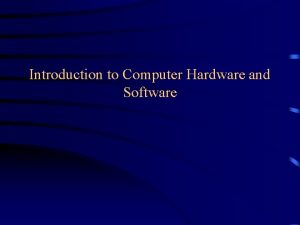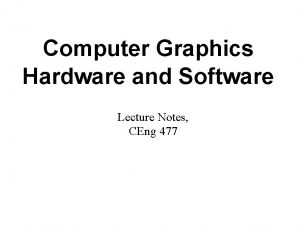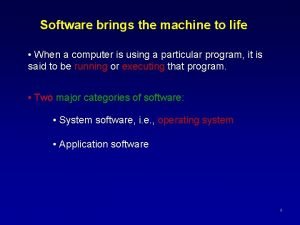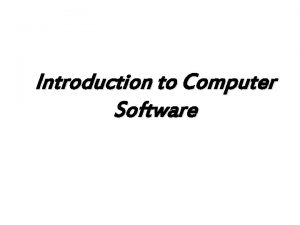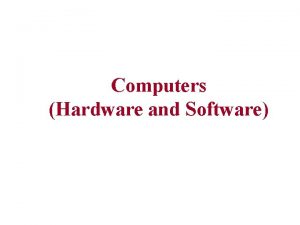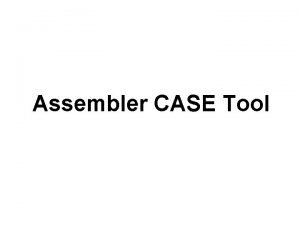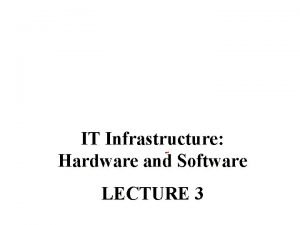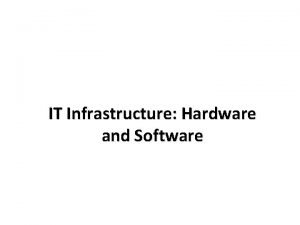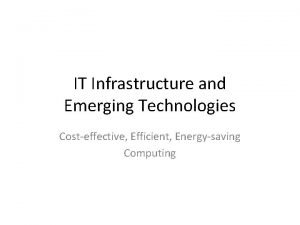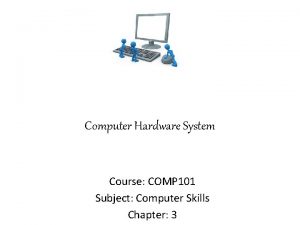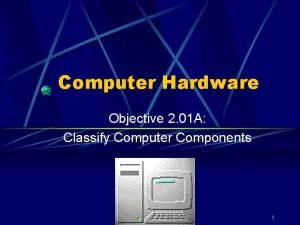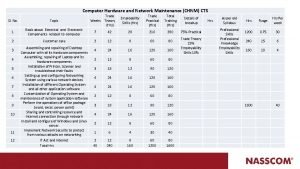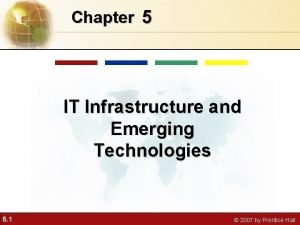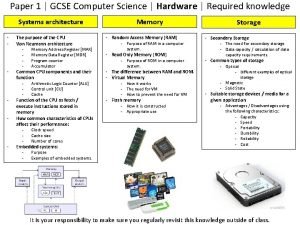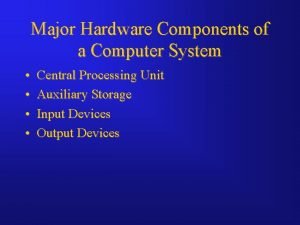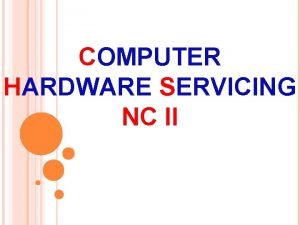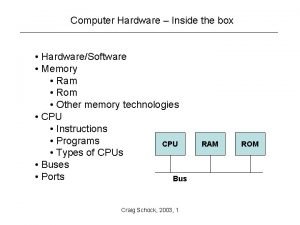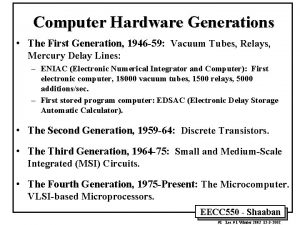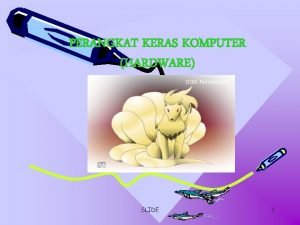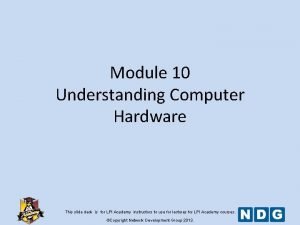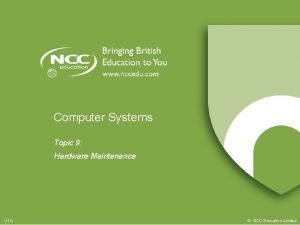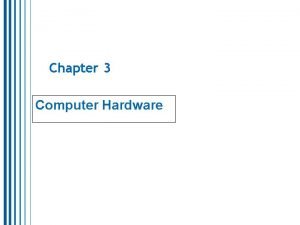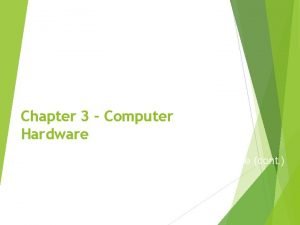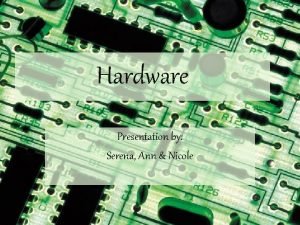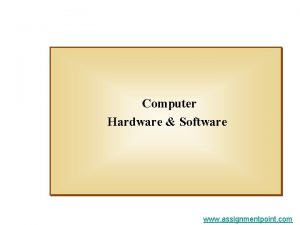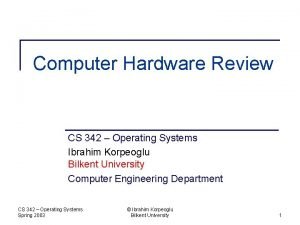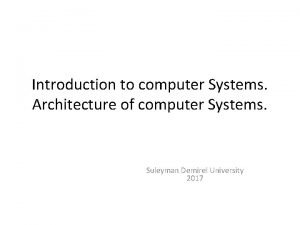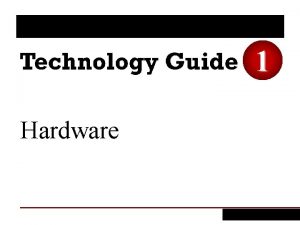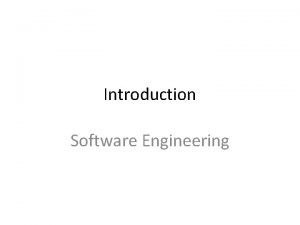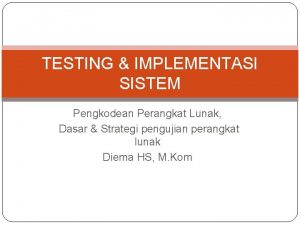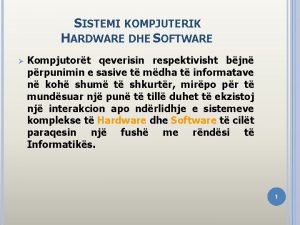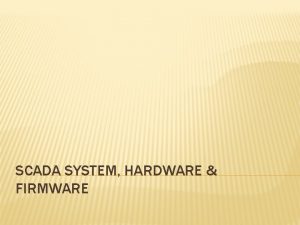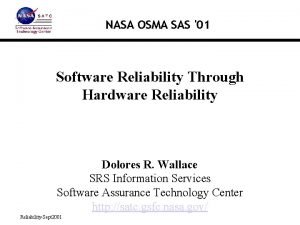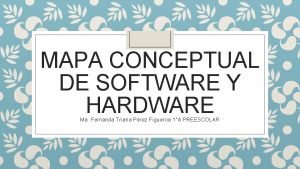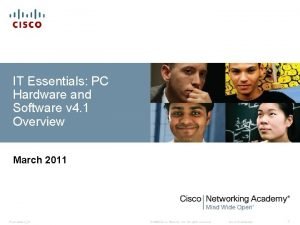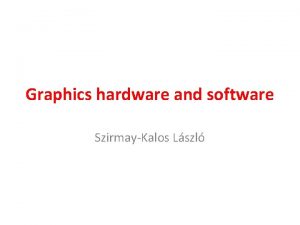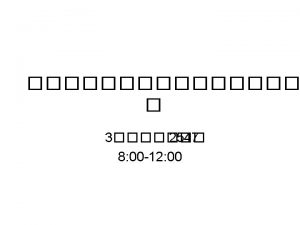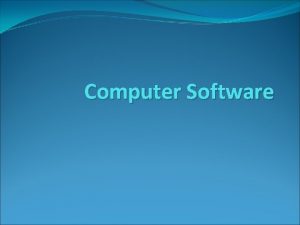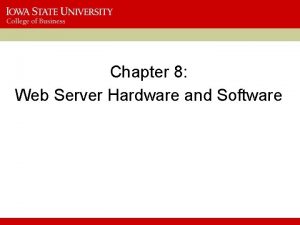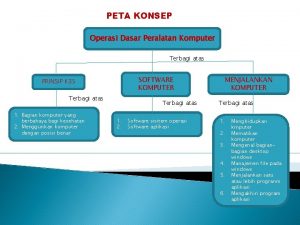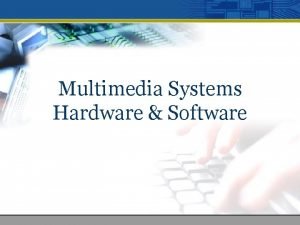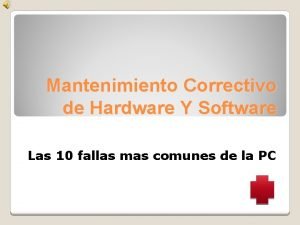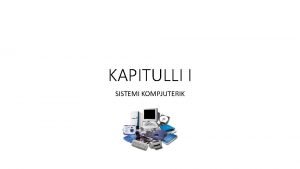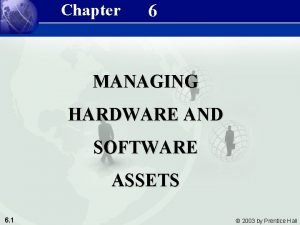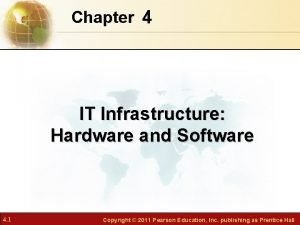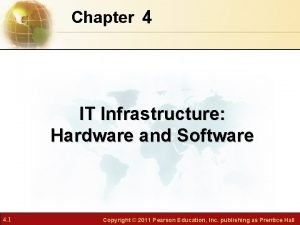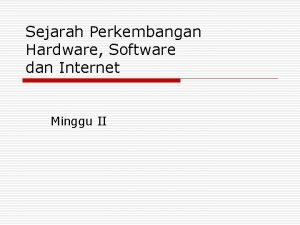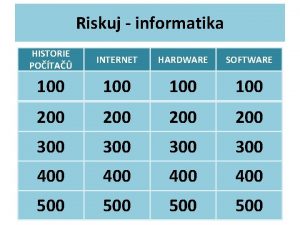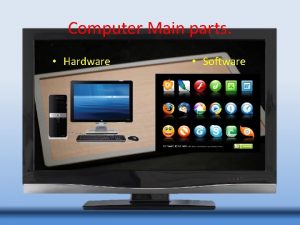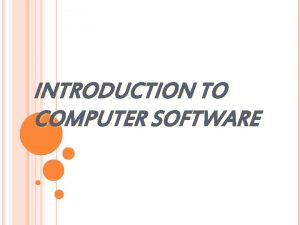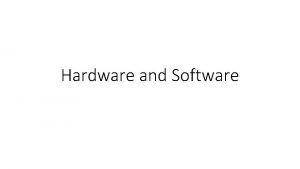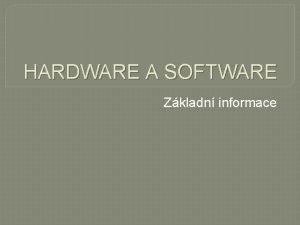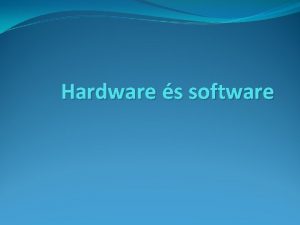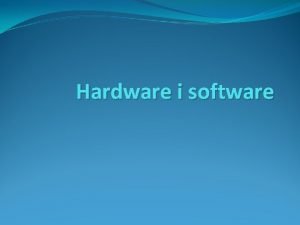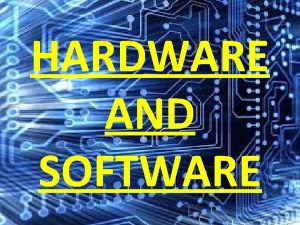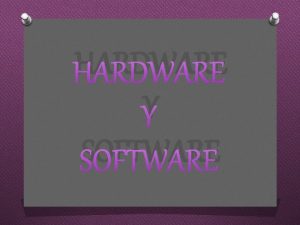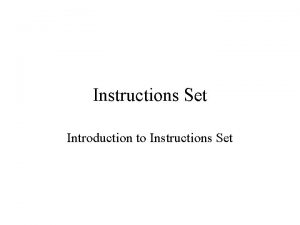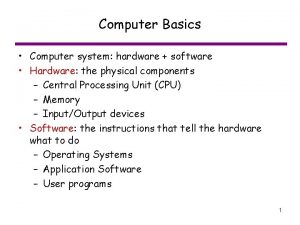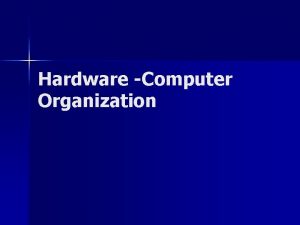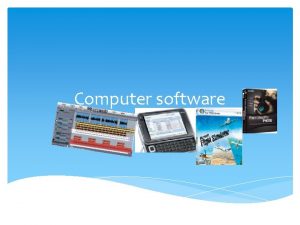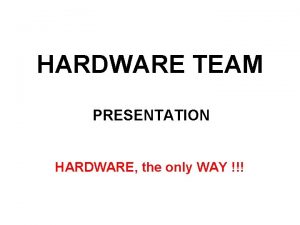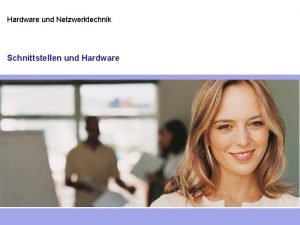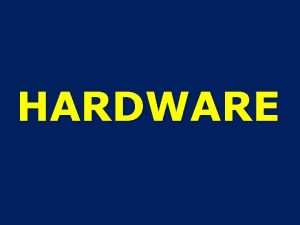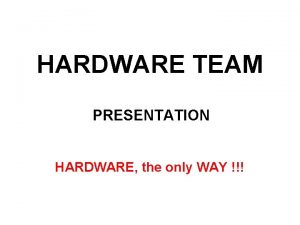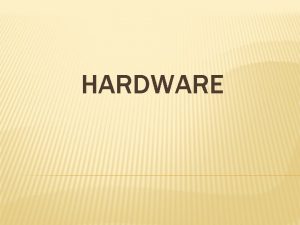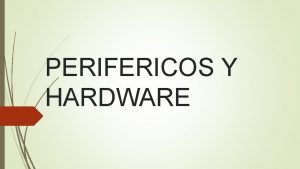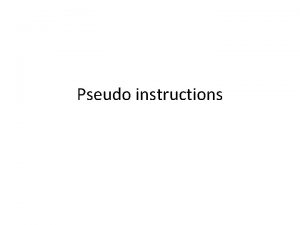Introduction to Computer Software Software Hardware Computer Instructions

































































- Slides: 65

Introduction to Computer Software

Software & Hardware? • Computer Instructions or data, anything that can be stored electronically is Software. • Hardware is one that is tangible. The storage devices (Hard disk, CD’s etc. , ), mouse, keyboard CPU and display devices (Monitor) are Hardware. For example: There is a problem in the Software implies – Problem with program or data

Types of Software System Software Application Software Open source Software and Proprietary Software

System Software: System Software includes the Operating System and all the utilities that enable the computer to function. System software is a term referring to any computer software which manages and controls the hardware so that application software can perform a task. Example: Operating Systems, Compiler, Loader, Linker, Interpreter.

Application Software: Application Software includes programs that do real work for user. Example: Payroll systems, Inventory Control, Manage student database, Word Processor, Spreadsheet and Database Management System etc. ,

Open Source Software: • Open source software (OSS) is computer software whose source code is available under a license that permits users to use, change, and improve the software, and to redistribute it in modified or unmodified form. • It is often developed in a public, collaborative manner. Well-known OSS products are Linux, Netscape, Apache, etc. ,

Proprietary Software: • Proprietary software (also called non-free software) is software with restrictions on using, copying and modifying as enforced by the proprietor. Restrictions on use, modification and copying is achieved by either legal or technical means and sometimes both. • Proponents of proprietary software Microsoft. • Ex: CAD, Nortan Antivirus etc. ,

System Software (contd): Linker: A linker or link editor is a program that takes one or more objects generated by compilers and assembles them into a single executable program. Linkers can take objects from a collection called a library. The objects are program modules containing machine code and information for the linker. The linker takes care of arranging the objects in a program's address space.

System Software (contd): Compiler: A compiler is a program that reads a program in one language – the source language and translates into an equivalent program in another language – the target language. Source Languages Target Languages ‘C’ language ‘Pascal’ language Machine language FORTRAN language C++ language ADA language

Application Software: Word Processors: Word processing is a tool that helps user in creating, editing, and printing documents. Word processors will normally have the following capabilities built into them: » Spell checking » Standard layouts for normal documents » Have some characters appear in bold print, italics, or underlined » Center lines, make text line up on the left side of the paper, or the right side of the paper » Save the document so it can be used again » print the document. Examples: Word. Perfect and Microsoft Word

Application Software (contd…): Spreadsheets: The spreadsheet packages are designed to use numbers and formulas to do calculations with ease. Examples of spreadsheets include: » Budgets » Payrolls » Grade Calculations » Address Lists The most commonly used spreadsheet programs are Microsoft Excel and Lotus 123.

Application Software (contd…): Graphic Presentations: The presentation programs can make giving presentations and using overheads easier. Other uses include: » Slide Shows » Repeating Computer Presentations on a computer monitor » Using Sound animation in slide shows The most recognized graphic presentation programs are Microsoft Power. Point and Harvard Graphics.

Application Software (contd…): Database Management System (DBMS): • A DBMS is a software tool that allows multiple users to store, access, and process data into useful information. • Database programs are designed for these types of applications: » Membership lists » Student lists » Grade reports » Instructor schedules All of these have to be maintained so you can find what you need quickly and accurately. • Example: Microsoft Access, d. BASE, Oracle.

Questions: 1. 2. 3. 4. Think about some machine / items / gadgets having only Hardware. Think about some machine / items / gadgets having both Hardware and Software. Find the Operating Syste, you are using and its version. Develop some application using n Word – processor n Spread sheet and list some important command. 5. Find 5 proprietary software names.

Installing and Uninstalling a Software

Double Click on the software you want to install

Click next

Click Install

Wait for installation

Click Finish

Uninstalling of a Software




Microsoft Paint

MS paint is a built in free software provided by Microsoft

With MS Paint You Can • • • Draw a Picture Or Anything Write on a Picture Resize Your Picture Change Resolution And many more. .

Click right button on the picture you want to Resize and Open with Paint

Resizing Your Picture

Crop

To copy, select the picture and press “ctrl+C” and then Press “ctrl+V”

Follow the Process you will find lots of pictures,

Writing on a Picture Or adding Shape

Rotating a Picture

Adobe Reader It is a free software Provided by Adobe Systems Inc. With Adobe Reader You can: • view PDF documents. • Print PDF docs • Copy text from PDF docs.

Web Browsers • Web browsers are programs used to explore the Internet. There are many Web browser programs available including Netscape Navigator, Internet Explorer and Opera. Internet Explorer is the Internet browser made by Microsoft and comes with Windows operating system.

Examples of web Browser • • Internet Explorer Mozilla Firefox Google Chrome Opera mini

Features of Web browser

What is a computer virus? • began in the late 1980 s as personal computers and electronic bulletin boards became more common. Back then, operating systems, word processing programs and other programs were stored on floppy disks. Hidden viruses were programmed onto these disks; as the disks were transferred from person to person, the virus spread.

What is a computer virus? • Computer viruses are small software programs that are designed to spread from one computer to another and to interfere with computer operation. • A virus might corrupt or delete data on your computer, use your e-mail program to spread itself to other computers, or even erase everything on your hard disk. • Viruses can be disguised as attachments of funny images, greeting cards, or audio and video files.

What is a computer virus? • Viruses are most easily spread by attachments in email messages or instant messaging messages. That is why it is essential that you never open e-mail attachments unless you know who it's from and you are expecting it. • Viruses also spread through downloads on the Internet. They can be hidden in illicit software or other files or programs you might download.

Types of Viruses • 1. Boot sector viruses are most predominant viruses until the mid-90 s. They infects boot sectors on diskettes and hard disks. On diskettes, the boot sector normally contains code to load the operating system files. • 2. Program viruses, the second type of computer viruses, infect executable programs; usually. COM and. EXE files, but they sometimes also infect overlay files, device drivers or even object files.

Types of Viruses • 3. The third type of viruses is Macro- viruses, which do not infect normal programs, but instead spread as "macros" in various types of files. This type of viruses can easily spread through E-mail, when users unknowingly exchange infected documents.

Types other than Viruses • Worms: A program or algorithm that replicates itself over a computer network and usually performs malicious actions. – Replicates itself automatically. – Can infect computers by Spyware, Malware, and Email. • Spam: Spam is flooding the Internet with many copies of the same message, in an attempt to force the message on people who would not otherwise choose to receive it.

Types other than Viruses • Virus Hoaxes – Do not carry a harmful payload, but do waste an incredible amount of time. • Trojan Horses: a malicious program that pretends to be a normal program. – Does not replicate itself like a worm. – Also comes in as an attachment with various file extensions. (. exe, . zip, . htm, etc…) – Installs backdoors.

Types other than Viruses • Adware: -Applications that monitor activity with express permission. • Spyware: -Applications that monitor activity without express permission. • Malware: - Any program or file that is harmful to a computer user. – Installs backdoors

Who Creates Viruses? • Where do viruses come from? • Every virus is created by an author with a different motive—but all virus builders feel their actions are justified. For some, a killer virus is the ultimate technical challenge, like climbing a mountain. For others, creating viruses is a form of self-expression. Some disgruntled employees, consumers or citizens turn to virus building as revenge for perceived injustices.

What Do Viruses Do? • Today’s viruses are far more potent than the beginner versions we saw several decades ago. Viruses may be sent by opening email attachments, clicking on spam, visiting corrupt websites and links online, opening spreadsheets or even the original method—infected disks. But the Internet is now the superhighway for virus transmission.

What Do Viruses Do? • A frightening prospect—opening an email from someone you trust to be greeted by a virus, and that’s exactly what the author is counting on, your trust. The damage caused by these viruses varies from minor delays in computer function to complete destruction of your hard drive. For companies, the price is far higher. A downed website can cost a company millions of dollars a day.

What Should I do if I have a Virus? • Clean your computer with anti-virus software. If your computer is still not functioning and you have data you are concerned about recovering, consider hiring a trusted expert. Often data can be successfully extracted from an injured hard drive, but the process is complex and will involve another computer, special software, and a technician with a lot of experience in data recovery.

How to remove a computer virus • Even for an expert, removing a virus from a computer can be a daunting task without the help of tools designed for the job. • Some viruses and other unwanted software (including spyware) are even designed to reinstall themselves after they have been detected and removed. • Fortunately, by updating your computer and using free, trial-period, you can help permanently remove (and prevent) unwanted software

Steps to help remove a virus: • 1. Visit web site for. Update and install the latest updates. • 2. If you currently use antivirus software, visit the manufacturer's Web site, update your software, and then perform a thorough scan of your computer. If you don't use antivirus software, subscribe to a service and scan your computer immediately.

Steps to help avoid viruses: • 1. Use an Internet firewall • (Note: Windows XP with SP 2 has a firewall already built-in and turned on by default). • 2. Visit any web site like Microsoft Update and turn on automatic updating. • Note: If you've installed Office 2003 or Office XP, Automatic Updates will also update your Office programs. • If you have an earlier version of Office, use Office Update.

How to help prevent computer viruses • Nothing can guarantee the security of your computer 100 percent. • You can continue to improve your computer's security and decrease the possibility of infection by using a firewall, keeping your system up-to-date, maintaining a current antivirus software subscription, and following a few best practices

How to help prevent computer viruses • Don’t automatically open email and email attachments. – Immediately delete emails from unknown sources. • Avoiding downloading files that you can’t be sure are safe. – Free games, screen savers, desktops, etc… • When in doubt, Err on the side of caution.

How to help prevent computer viruses –Anti Virus Software – – If you don’t have it, GET IT !! ~Norton Anti. Virus ~Mc. Afee Virus Sheild ~kaspersky Anti. Virus – Keep your virus software updated! – Verify that it your virus software is working.

Virus Infection of more than 75, 000 vulnerable computers in 10 minutes

What is an Anti-Virus? • Anti-virus is a software (computer program) that scans files or your computer's memory for certain patterns that may indicate an infection. The patterns it looks for are based on the signatures, or fingerprints, of known viruses. Once a virus is detected in the wild, the Anti-Virus companies then release these new patterns for your Anti-virus software to use. These updates come out daily by some vendors. Virus authors are continually releasing new and updated viruses, so it is important that you have the latest definitions installed on your computer.

What is an Anti-Virus? • Once you have installed an anti-virus package, you should scan your entire computer periodically. Always leave your Anti-virus software running so it can provide constant protection. • Automatic scans- Depending what software you choose, you may be able to configure it to automatically scan specific files or directories and prompt you at set intervals to perform complete scans. •

What is an Anti-Virus? • Manual scans- It is also a good idea to manually scan files you receive from an outside source before opening them. • This includes: • Saving and scanning email attachments or web downloads rather than selecting the option to open them directly from the source • Scanning floppy disks, CDs, or DVDs for viruses before opening any of the files

Types of Anti-virus product: • Depending on the installation method of the Anti-Virus these can be in the following forms: On-Access, On-Demand, and hardware. • On-access scanners check for viruses when files or floppy disks are "accessed". They are designed to run transparently in the background. When well implemented they should be invisible to the user - they shouldn’t even realize they are running an anti-virus product until it intercepts a virus. It has been our experience that on-access scanners are the most popular type of anti-virus product.

Types of Anti-virus product: • On-demand scanners only execute when the user tells them to execute. In other words they only scan for viruses when the user tells them, for example, to scan the floppy disk they have just inserted. The drawback with this method is that users have to remember to scan files and disks for viruses.

Types of Anti-virus product: • Hardware anti-virus products tend to be unpopular. The reason for this is that it is considerably harder to install a hardware card into many hundreds of PCs than it is to install computer software. Furthermore, difficulties may arise if the hardware anti-virus needs to be updated to deal with new threats (macro viruses for example).

Types of Anti-virus product: • Depending on the way they fix viruses these can be in the following forms: Anti-Virus, Anti-spyware, and Anti-spam Applications. • Anti-viruses: • Antivirus software consists of computer programs that attempt to identify, thwart and eliminate computer viruses and other malicious software (malware). • Antivirus software typically uses two different techniques to accomplish this:

Thanks
 Introduction of computer hardware and software
Introduction of computer hardware and software Internal hardware
Internal hardware What is computer
What is computer Software brings the machine to life
Software brings the machine to life Hardware introduction
Hardware introduction A computer system consists of both hardware and software
A computer system consists of both hardware and software Pseudo instructions
Pseudo instructions Assembler in computer
Assembler in computer Storage holds for future use
Storage holds for future use Instructions language of the computer
Instructions language of the computer Lmc little man computer
Lmc little man computer Data or instructions entered into the computer
Data or instructions entered into the computer Software is a set of instructions
Software is a set of instructions Language tool
Language tool Software and its types
Software and its types Computer hardware platforms in it infrastructure
Computer hardware platforms in it infrastructure Computer arithmetic: algorithms and hardware designs
Computer arithmetic: algorithms and hardware designs Computer hardware 101
Computer hardware 101 Computer hardware classification
Computer hardware classification Hardware and network maintenance
Hardware and network maintenance Computer hardware platforms in it infrastructure
Computer hardware platforms in it infrastructure Graphic organizer of computer hardware
Graphic organizer of computer hardware Hardware gcse computer science
Hardware gcse computer science Parts of computer system
Parts of computer system Computer hardware servicing nc2
Computer hardware servicing nc2 Computer hardware
Computer hardware First generation of computer
First generation of computer Mengidentifikasi berbagai komponen perangkat keras komputer
Mengidentifikasi berbagai komponen perangkat keras komputer Computer hardware slides
Computer hardware slides Introduction to computer graphics - ppt
Introduction to computer graphics - ppt Types of computer hardware maintenance
Types of computer hardware maintenance Computer hardware history
Computer hardware history 3 computer hardware components
3 computer hardware components Hardware presentation
Hardware presentation Objectives of computer hardware
Objectives of computer hardware Computer hardware review in operating system
Computer hardware review in operating system Functions of system unit
Functions of system unit Computer hardware simulator
Computer hardware simulator Hardware identify
Hardware identify Computer software introduction
Computer software introduction Basic coding test
Basic coding test Pjeset hardware dhe software
Pjeset hardware dhe software Scada is a software or hardware
Scada is a software or hardware Difference between hardware and software
Difference between hardware and software Mapa mental de software y hardware
Mapa mental de software y hardware It essentials virtual desktop simulator online
It essentials virtual desktop simulator online Perangkat lunak jaringan komputer
Perangkat lunak jaringan komputer Alu hardware
Alu hardware Vbo1
Vbo1 Hardware software peopleware
Hardware software peopleware Interface between hardware and software
Interface between hardware and software Web server hardware
Web server hardware Hardware and software reliability
Hardware and software reliability Peta konsep tentang komputer
Peta konsep tentang komputer Persyaratan spesifikasi perangkat
Persyaratan spesifikasi perangkat Multimedia software and hardware
Multimedia software and hardware Mantenimiento correctivo hardware y software
Mantenimiento correctivo hardware y software Pjeset software te kompjuterit
Pjeset software te kompjuterit Mapa mental de software y hardware
Mapa mental de software y hardware Managing hardware and software assets
Managing hardware and software assets Hardware and software infrastructure
Hardware and software infrastructure It infrastructure hardware and software
It infrastructure hardware and software Hardware x software
Hardware x software Hardware y software 1 eso
Hardware y software 1 eso Perkembangan hardware dari masa ke masa
Perkembangan hardware dari masa ke masa Hardware software informatika
Hardware software informatika
